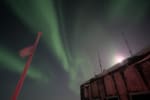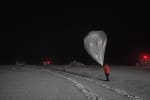While most of us up north are enjoying longer and brighter days as summertime gears up, the South Pole remains settled in winter. The image above of frosted and snowed-in IceCube drill towers is a wintry scene indeed. Though, to be fair, the drill towers were rather snow covered in summer as well. (Here’s an […]
Winners of IceCube machine learning competition announced
Last month, the IceCube Collaboration concluded their “IceCube – Neutrinos in Deep Ice” Kaggle competition that launched in January, 2023. Participants were challenged to devise a machine-learning solution that could quickly and accurately process a large number of events to identify the direction that neutrinos came from. Over the course of three months, 11,000 solutions […]
Week 21 at the Pole
Some weeks are busier than others, and last week was one of them, at least as far as the IceCube detector goes. There were just a number of issues that seemed to arise one after the other, like hard drive errors and DOM warnings—nothing IceCube’s intrepid winterovers couldn’t handle. But if you’re going to be […]
Week 20 at the Pole
Bad weather last week at the Pole meant more indoor photos than outdoor photos. But starting with the out-of-doors, the image above shows the front of the station entrance with a snowdrift that had built up after only a few days of heavy winds. They had to carve a passage through the drift for people […]
Week 19 at the Pole
The main activity occupying IceCube’s winterovers last week was running DOM calibration on all of IceCube’s in-ice modules, a big effort compared to their usual task of calibrating just the IceTop DOMs. Besides other work on the detector, they also had emergency response training and put in some time helping deep clean the galley chairs […]
IceCube search for correlation of high-energy neutrinos with active galactic nuclei and blazars
The IceCube Neutrino Observatory, a cubic-kilometer-sized telescope at the South Pole, has been issuing real-time alerts to the public within minutes of the detection of astrophysical, ghostlike particles called neutrinos. However, the sources of the astrophysical neutrinos detected by IceCube remain largely unknown. One class of objects that are probable sources of astrophysical neutrinos are […]
Week 18 at the Pole
IceCube winterover Hrvoje, who took the photo above, was excited to see the sun coming up again at the South Pole, except…that’s the moon and not the sun! (Of course, he knew that all along.) But what an illusion, this image of the moon—it could fool anyone. And the moon has played such games before. […]
IceCube measurement of atmospheric neutrino mixing using improved DeepCore calibration, data processing
When cosmic rays strike Earth’s atmosphere, they produce air showers containing atmospheric muons and neutrinos—tiny, nearly massless particles—that rain down on Earth. The atmospheric neutrinos are then detected by the IceCube Neutrino Observatory at the South Pole. These atmospheric neutrinos come in three different flavors—electron, muon, and tau–and can become a different flavor or “oscillate” […]
Week 17 at the Pole
First up—last week featured a weather balloon launch. That’s IceCube winterover Marc lending his assistance. He also spent some time helping out with preparations for a repair to one of the power generators. A trip to the South Pole power plant is always an interesting visit. Last week’s activities also included some detector troubleshooting, a […]
Week 16 at the Pole
Ahh, auroras! We knew they’d come…and now the first of the season have been captured by IceCube’s winterovers. It’s still not completely dark outside, but the skies are still impressive. Above are the first faint auroras seen over the South Pole station, and below seen over the Dark Sector, with the IceCube Lab (ICL) visible […]









